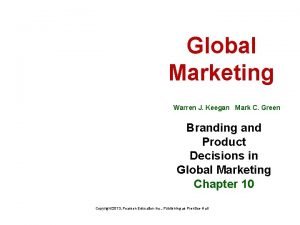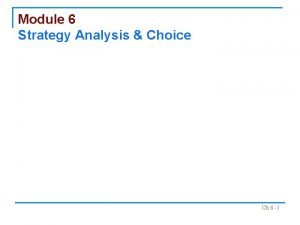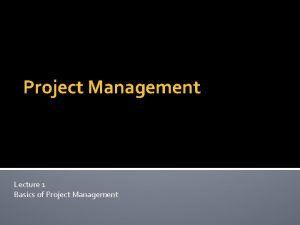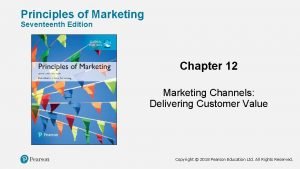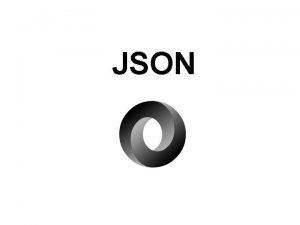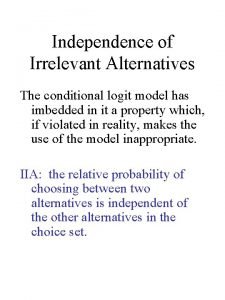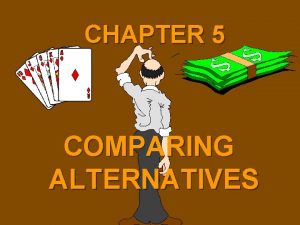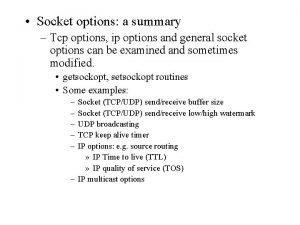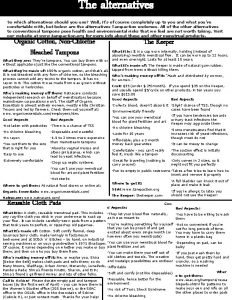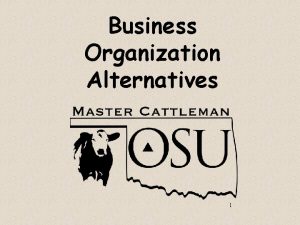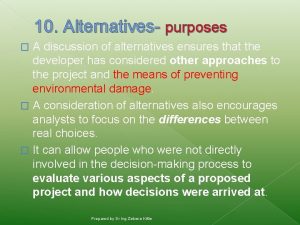Strategic management Lecture 6 Strategic alternatives strategic options




































- Slides: 36

Strategic management Lecture 6. Strategic alternatives, strategic options


The most important strategic problems (1) n n n Decreasing profitability and low return on investment Decreasing market share Decreasing stockholder wealth Deteriorating financial position Rising overall costs Growing debt and week balance sheet

The most important strategic problems (2) n n Deterriorating of competitive advantages Decreasing quality, and the loyalty of main customers The growth rate lower than the industry avarage Obsolate facilities and technical infrastructure

The most important strategic problems (3) n n n Decreasing innovativity, slow product innovation Weakening the brand image Lots of underutilised plant capacity Entry a new strong competitor, or increasing competition within the industry Costly new regulatory requirements Long-term shift in buyer needs

DEVELOPMENT STRATEGIES What basis? Bases of competitiv strategy Cost leadership Differentiation Which direction? Alternative Directions Alternative methods Protect and build Internal development Market penetration Acquisition Product development Joint Development/ alliances Market development Focus strategies How? Diversification: related unrelated

Porter’ generic strategies Porter’s experience R OI Differentiation Cost leadership Market share

Sources of Competitive Advantage COMPETITIVE ADVANTAGE COST ADVANTAGE ct u d ro p r st la o i c m r Si we o l at fro m Pri ce un pre iqu mi um ep rod uc t DIFFERENTIATION ADVANTAGE

PORTER’S generic strategies Competitive advantages: Low cost Differentiation. Low cost leadership Scope of activities: broad Standard products Differentiation Unique products Great volume Small volume Low production costs High production cost Best cost provider Scope of activities: narrow Low cost leadership focus Differentiation focus

Low cost leadership n n n n Production emphasis: ‘nobody could do it cheaper’ Marketing/production emphasis: ‘Low prices and outstanding value for money’ Operating culture: no frills, reputation for being ‘lean and mean’ Economies of scale from high volume Process innovation to cut costs High productivity per employee Price cuting as an offensive or defensive weapon Low profit marginsin return for high volume

Broad differentiation n n n n Production emphasis: ‘nobody could make it better’ Marketing/production emphasis: ‘Simply the best there is’ Operating culture: many frills – the widest range of options and features, something for every taste. Creating something different from competitors product/services Product innovation to bring new products with new options to the market. Premium pricing to cover cost of differentiation Low volume but high profit margin Intensive adertising and sales efforts

Focus strategies n n n Production emphasis: ‘we taylor our products to meet your particular needs’ Production emphasis: ‘Just for you’ Specialization: buyer segments, geographic areas, final-use applications. Marketing emphasis: We’ar not a ‘Jack of all trade’, we are master of one. Competitive advantage in target segment depends on either: 1. Low cost leadership (spaecialised experience or knowledge advantage) 2. Succesfull differentiation (offering somethig unique)

Features of Cost Leadership and Differentiation Strategies Generic strategy COST LEADERSHIP DIFFERENTIATION Key strategy elements Resource & organizational requirements Scale-efficient plants. Access to capital. Process Design for manufacture. engineering skills. Frequent Control of overheads & reports. Tight cost control. R&D. Avoidance of Specialization of jobs and marginal customer functions. Incentives for accounts. quantitative targets. Emphasis on branding and brand advertising, design, service, and quality. Marketing. Product engineering. Creativity. Product R&D Qualitative measurement and incentives. Strong cross-functional coordination.

Differentiation and Segmentation DIFFERENTIATION: is concerned with how a firm distinguishes its offerings from those of its competitors (i. e. How the firm competes) SEGMENTATION: is concerned with which customers, needs, localities a firm targets (i. e. Where the firm competes) DOES DIFFERENTIATION IMPLY SEGMENTATION? —Not necessarily, depends upon the differentiation strategy: BROAD SCOPE DIFFERENTIATION Appealing to what is common between different customers (Mc. Donalds, Honda, Gillette) FOCUSED DIFFERENTIATION Appealing to what distinguishes different customer groups (Harley-Davidson, Ralph Lauren)

Drivers of Cost Advantage ECONOMIES OF SCALE ECONOMIES OF LEARNING PRODUCTION TECHNIQUES PRODUCT DESIGN INPUT COSTS • Indivisiblities • Specialization and division of labor • Increased dexterity • Improved organizational routines • Process innovation • Reengineering business processes • Standardizing designs & components • Design for manufacture • Location advantages • Ownership of low-cost inputs • Non-union labor • Bargaining power CAPACITY UTILIZATION • Ratio of fixed to variable costs • Speed of capacity adjustment RESIDUAL EFFICIENCY • Organizational slack; Motivation & culture; Managerial efficiency

The Nature of Differentiation DEFINITION: “Providing something unique that is valuable to the buyer beyond simply offering a low price. ” (M. Porter) THE KEY IS TO CREATE VALUE FOR THE CUSTOMER TANGIBLE DIFFERENTATION Observable product characteristics: • size, color, materials, etc. • performance • packaging • complementary services INTANGIBLE DIFFERENTATION Unobservable and subjective characteristics that appeal to customer’s image, status, identity, and desire for exclusivity TOTAL CUSTOMER RESPONSIVENESS Differentiation not just about the product, it embraces the whole relationship between the supplier and the customer.

Strategy Development Directions Source: Adapted from H. Ansoff, Corporate Strategy, Penguin, 1988, Chapter 6. Exhibit 7. 1

Protect and Build Consolidation - Protect and strengthen position in current markets with current products n n Downsizing or withdrawal from activities Maintenance of market share Market penetration - Organisation gains market share n n Leverage competences Desirability of dominant market share

Market Development Offer existing products in new markets n n New market segments with similar CSFs New uses for existing products New geographic markets Issues • Normally requires some product development and capability development • Credibility and expectations

Product Development n Associated dilemmas • Expense, risk and potential unprofitability • Unacceptable consequences of not developing new products

Diversification A strategy that takes the organisation away from both its current markets and products n n Related diversification Unrelated diversification

Reasons to diversify Least power to create value Reduce risk Maintain growth Most power to create value Balance cash flows Not recommended as a reason to diversify Share infrastructure Increase market power Extend competences Recommended as a reason to diversify

Related diversification options for a manufacturer BACKWARD INTEGRATION Raw materials manufacture Raw materials supply Components manufacture Machinery manufacture Product/process research/design Machinery supply Financing Components supply Transport HORIZONTAL INTEGRATION Competitive products Complementary products Manufacturer By-products FORWARD INTEGRATION Distribution outlets Transport Marketing information Repairs and servicing

Methods of Strategy Development n Internal Development • Organic development • Build on and develop an organisation’s own capabilities n Mergers and Acquisitions • Take over ownership of another organisation n Strategic Alliances • Two or more organisations share resources and activities

Advantages and disadvantages of internal development Avantages Disadvantages Can be relatively cheap Can be relatively slow You can manage on your own Lower investment than buy a company You can learn how to do You lack of expertise Its risky to enter a new field To learn a new technology is slow You can use existing There are big difference organization, and culture between two culture

Advantages and disadvantages of aquisition Avantages Disadvantages Can be relatively fast Premium paid: expensive Cost savings from economie of scale Extend to new geogrephic areas Buy market size and share May reduce competition from a rival Not alwais easy to dispose of anwanted parts Human relations problems that can arise after Problem of clash of national, and organizational culture High risk if wrong company targeted

Advantages and disadvantages of joint venture Avantages Disadvantages Builds scale quickly Control lost to some extent Obtain special expertise quickly Woks best where both parties contribute something different Cheaper than acquisition Can be difficult to manage Can be use when outright acquisition not feasible Profit share with partner Can be used where similar product available

Advantages and disadvantages of alliance Advantages Disadvantages Can be build close contacts with parener Slow and plodding approach Use joint expertise and commitments Needs constant work to keep relationship sound Allows potential partners Partners may only have to learn about each other limited commitments Locks out other competitors Unlikely to build economie of scale

Motives for Internal Development Environment Capabilities Expectations Lack of choice – Develop highly breaking new technical products inground/only one in house to create core field competence Avoid culture clash Inability to find suitable acquisition target Develop new markets – Avoid potential direct involvement to incompatibility increase understanding & create core competence Spread cost over time – easier for companies with limited resources

Motives for Strategic Alliances n Need for critical mass • Cost reduction • Improved customer offering n Co-specialisation • Each partner concentrates on using own capabilities, e. g. geographical market entry, value chain activities, Public Finance Initiative n Learning • Helps to develop future competences

Motives for Mergers and Acquisitions Environment Capabilities Expectations Speed in fast-moving product/market Exploit core competences in new arena Institutional shareholders want continuing growth Competitive situation – static market, avoid competitor reaction Address lack of resources or competences Ambitions of senior managers Deregulation – created Cost efficiency suboptimal units ripe for acquisition Financial – Learning opportunistic acquisition of firm with low share value Speculative to boost short-term share value

Most important strategic answers (1) n n n Globalization Implementation of e-business or/and related management methods Merger and acquisitions Create strategic alliances Divest (harvest) and find new industry or a new niche Crisis management and consolidation

Most important strategic answers (2) n n n n Diversification and re-positioning the company Focus and back to basic Benchmaring and outsourcing Vertical and horizontal integration Re-engineering the structure and processes. Rebuild the organizational culture Create a new more competitive corporate governance structure

Recent Approaches to Cost Reduction CORPORATE RESTRUCTURING BUSINESS PROCESS REENGINEERING Dramatic changes in strategy and structure to adjust to the business conditions of the 1990’s Key elements: n Plant closures n Outsourcing n Delayering and cuts in administrative staff The fundamental rethinking and radical redesign of business processes to achieve dynamic improvements in performance. e. g. : n Several jobs combined into one n Steps of a process combined in natural order n Minimizing steps, controls, and reconciliation n Use case managers as single points of contact n Hybrid centralization/ decentralization

Types of and motives for strategic alliances

Three ways to grow a business Whether a business brings in $10, 000 a year or $10 m, they can start to grow by using three simple strategies, says Terri Levine, a business mentoring expert. • Increase prospects: Establish internally why customers should be turning to you instead of competitors. Then, make that message the core of advertising and marketing campaigns, and use it to dictate which customers you target. • Increase conversion rate: Most small firms don't track the conversion rate from prospects to sales, but it can be worth investing in software that does. Once you know the real rate, you can better reach out to those who got away to determine your weaknesses. • Increase customer worth: Look to increase sales by offering more or raising the value of your services. "Don't be afraid to raise prices, " says Levine, who notes that even in this economy, businesses providing wanted services have been able to raise their rates by 10%.
 Strategic management lecture
Strategic management lecture 01:640:244 lecture notes - lecture 15: plat, idah, farad
01:640:244 lecture notes - lecture 15: plat, idah, farad Global product planning strategic alternatives
Global product planning strategic alternatives Brand and product decisions in global marketing
Brand and product decisions in global marketing Swot tows matrix
Swot tows matrix Chapter 6 strategy analysis and choice
Chapter 6 strategy analysis and choice Tows matrix
Tows matrix Analysing the 6 strategic options megxit
Analysing the 6 strategic options megxit Strategic competitiveness
Strategic competitiveness Options futures and risk management
Options futures and risk management Options futures and risk management
Options futures and risk management Project procurement management lecture notes
Project procurement management lecture notes Project management lecture
Project management lecture Project quality management lecture notes
Project quality management lecture notes Financial management lecture
Financial management lecture Introduction to public sector accounting
Introduction to public sector accounting Om306
Om306 Performance management lecture
Performance management lecture Human resource management 15th edition
Human resource management 15th edition Intro to human resource management
Intro to human resource management Human resource management lecture chapter 1
Human resource management lecture chapter 1 Project cost management lecture notes
Project cost management lecture notes Project management lecture
Project management lecture Unified health management information system
Unified health management information system Risk management lecture
Risk management lecture Project planning and management lecture notes ppt
Project planning and management lecture notes ppt Telecommunication network management lecture notes
Telecommunication network management lecture notes Creat khoot
Creat khoot In conclusion alternatives
In conclusion alternatives Standardized testing alternatives
Standardized testing alternatives Identify the major channel alternatives open to a company.
Identify the major channel alternatives open to a company. Vertex smb alternatives
Vertex smb alternatives In conclusion alternatives
In conclusion alternatives Ncsu webassign
Ncsu webassign Alternatives to surgery for laryngeal paralysis in dogs
Alternatives to surgery for laryngeal paralysis in dogs Bnf json
Bnf json Independence of irrelevant alternatives multinomial logit
Independence of irrelevant alternatives multinomial logit


